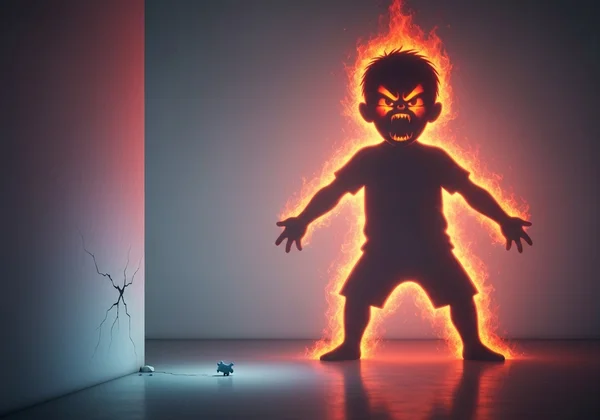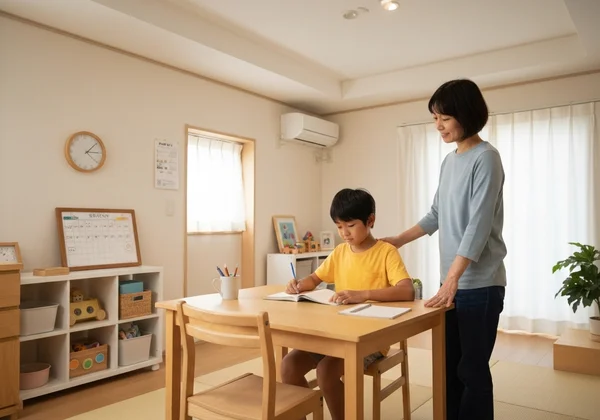儿童和青少年间歇性爆发性障碍 (IED):家长应对爆发性愤怒的指南
作为父母,您会预料到各种挑战。您会预料到孩子擦伤膝盖、房间凌乱以及偶尔发脾气。但是,当您的孩子或青少年的愤怒表现得与众不同时会发生什么呢?当他们的爆发如此强烈、突然和不成比例,以至于让所有家庭成员都感到震惊和困惑时,感到担心是很自然的。您可能会问自己一个难题: 您是否在为孩子的愤怒是否只是一个阶段而困惑?

如果您正与一个似乎无法控制自己爆发性愤怒的孩子搏斗,您并不孤单。本指南旨在帮助您应对青少年间歇性爆发性障碍 (IED) 的复杂性。我们将探讨它是什么,它与典型的儿童愤怒有何不同,以及您可以采取哪些措施来支持您的孩子和家人。了解这些迹象是迈向和平与稳定的第一个关键步骤。如需更多见解,您可以随时 探索我们的资源。
了解青少年间歇性爆发性障碍
应对行为障碍的世界可能会让人不知所措。让我们首先澄清间歇性爆发性障碍在儿童和青少年背景下的真正含义。它不仅仅是“脾气暴躁”或“脾气不好”。它涉及一种真正的冲动控制困难,导致反复的、爆发性的发作。
什么是 IED 以及它如何影响儿童和青少年?
间歇性爆发性障碍 (IED) 是一种公认的精神健康状况,其特征是反复出现的行为爆发,表现为无法控制攻击性冲动。在儿童和青少年中,这不仅仅是反抗;它是一种突然、强烈愤怒的模式,其程度与触发因素严重不成比例。例如,一个微小的挫折,如被告知关闭视频游戏,可能会导致尖叫、扔东西或肢体冲突。
这些发作并非预谋。它们是冲动的,事后常常让孩子感到难过、懊悔或尴尬。其影响可能很大,会影响他们与家人和朋友的关系、他们在学校的表现以及对他们自尊的打击。了解这种情况是提供正确 心理健康支持 的关键。
IED 与典型发脾气的区别
几乎每个孩子都会发脾气,尤其是在幼儿时期。那么,如何区分哪些是发展正常的表现,什么可能是 IED 的迹象呢?区别在于发作的频率、强度和性质。
典型的发脾气通常是有目的性的;孩子想要一个玩具,便会大发脾气以求得到。一旦他们得到想要的东西(或意识到得不到),脾气通常就会平息。
然而,IED 的愤怒爆发有所不同:
- 冲动性: 它们并非计划好的,似乎突然出现,由轻微的挑衅引发。
- 强烈性: 愤怒的程度远远超出与情况严重不成比例。
- 短暂性: 愤怒的爆发通常很短暂,通常持续不到 30 分钟。
- 伴随懊悔: 发作之后,孩子常常感到后悔、羞耻或极度悲伤。
认识到这些差异对父母来说是关键一步。如果您的孩子的愤怒似乎符合这种模式,可能是时候 了解更多关于 IED 的信息 了。
识别迹象:何时寻求 儿童 IED 的帮助
查明 儿童 IED 的迹象对于早期干预至关重要。虽然只有合格的专业人士才能做出诊断,但父母是首先接触到孩子的人,可以识别出预示着更深层问题的行为模式。了解需要注意什么,能让您有能力采取下一步行动。
青少年 IED 的主要症状和行为模式
根据 DSM-5(精神疾病诊断与统计手册)中概述的诊断标准,IED 的症状分为两大类攻击性行为表现:
- 言语攻击或非破坏性身体攻击: 这包括发脾气、长篇大论、言语争吵或对个人、动物或物体进行非破坏性身体攻击。对于潜在的 IED 诊断,这些情况必须平均每周发生两次,持续三个月。
- 破坏性身体攻击: 这涉及更严重的爆发,其中财产受损或个人或动物受到人身伤害。在 12 个月内发生三次此类爆发可能表明患有该疾病。
正是这种未能控制这些冲动的反复模式定义了 IED。儿童必须至少六岁才能考虑诊断。
危险信号:超出年龄范围的愤怒
除了具体的诊断标准之外,还有一些危险信号表明孩子的愤怒已经超出了正常范围,进入了问题范畴。如果您注意到以下情况,请考虑寻求指导:
-
反应不成比例: 您的孩子的愤怒始终且明显地大于引发问题的事件。
-
高频率: 爆发性发作经常发生,而不仅仅是在少数特别糟糕的日子里。
-
失控: 在爆发期间,您的孩子似乎完全失控,仿佛他们无法控制自己,任由愤怒摆布。
-
对功能的影响: 愤怒正在阻碍他们在学校取得成功、维持友谊或参与家庭生活。
-
家庭困扰: 爆发在家中造成持续的紧张、恐惧或身心俱疲。

如果这些危险信号让您感到熟悉,请知道有办法继续前进。这段旅程始于理解并寻求 准确的诊断。
应对 有爆发性愤怒的儿童 的有效策略
养育一个有爆发性愤怒的孩子,会让父母感到孤立和筋疲力尽。然而,通过正确的策略,您可以帮助管理孩子的行为,减少爆发的频率,并创造一个更平和的家庭。您的角色不是“修复”他们,而是提供一个稳定、支持性的基础,帮助他们学会管理自己的情绪。
创建一个支持性和可预测的家庭环境
有冲动控制问题的儿童受益于结构化和可预测性。不稳定或混乱的环境会增加压力,更容易引发爆发。通过以下方式,专注于创建一个 支持性的家庭环境 :
-
建立清晰的日常: 吃饭、做作业和睡觉的固定时间表可以减少焦虑。
-
设定坚定而公平的界限: 规则应该清晰、一致,并平静地沟通。违反规则的后果应该是合乎逻辑的,并且在不带愤怒情绪的情况下执行。
-
规划过渡: 在切换活动之前给孩子预警(例如,“你还有五分钟的屏幕时间”)。
-
创建“冷静”空间: 在家中指定一个安全、安静的区域,让孩子在感到不知所措时可以去那里调节情绪。

父母的沟通和降级技巧
在愤怒升级的时刻,您的做法要么火上浇油,要么有助于控制局面。学习有效的 降级技巧 至关重要。
- 保持冷静: 您保持冷静本身是您最有力的工具。如果您以同样的愤怒回应,情况只会恶化。
- 确认感受,而非行为: 例如,可以说‘我能看出你现在很生气’,但要接着强调‘扔东西是不对的’。
- 使用简洁的语言: 在爆发期间,孩子的理性大脑处于离线状态。保持句子简短,语气中立。
- 给予他们空间: 除非他们对自己或他人构成危险,否则不要过于靠近或触摸他们。过近的距离可能会让人感到威胁。
实践这些策略可以带来显著的改变。如需更多指导,浏览我们的网站可以提供更多 愤怒管理技巧。
迈出下一步:儿童 IED 的评估和 治疗
虽然育儿策略至关重要,但它们通常在与专业支持相结合时才能发挥最佳效果。如果您怀疑您的孩子患有 IED,寻求正式评估是至关重要的一步。这能提供明确的诊断,并为有效的、基于证据的治疗打开大门。
为什么专业评估对于准确诊断至关重要
由儿童心理学家、精神科医生或其他合格的精神健康专家进行的 专业评估 至关重要。许多疾病,如 ADHD(注意力缺陷多动障碍)、对立违抗性障碍 (ODD)、焦虑或创伤,都可能表现出类似的愤怒和攻击性症状。全面的评估将有助于区分 IED 与其他可能导致类似症状的疾病,确保您的孩子获得正确的诊断和最合适的治疗计划。这一步不是为了给您的孩子贴标签;而是为了理解他们。
青少年 IED 的治疗方法和支持系统
幸运的是,儿童和青少年的 IED 是可以治疗的。治疗通常侧重于帮助孩子培养管理愤怒和控制冲动的技能。常见的 治疗方法 包括:
-
认知行为疗法 (CBT): 这通常是主要的治疗方法。CBT 帮助儿童识别爆发前的思想和感受,并教导他们新的、更健康的应对挫折和愤怒的方法。
-
家庭疗法: 由于 IED 影响整个家庭,家庭疗法(包括父母和兄弟姐妹的参与)对于改善沟通和制定统一的支持策略非常有益。
-
家长管理培训: 这为家长提供了有效管理孩子行为的具体技巧。
-
药物治疗: 在某些情况下,精神科医生可能会开药来帮助管理冲动或情绪不稳定等潜在问题。

找到合适的支援系统是迈向充满希望的未来的关键。我们的网站是 更好地了解 IED 并为与专业人士的对话做准备的重要第一步。
赋能您的孩子和家庭:寻找前进的道路
养育一个患有间歇性爆发性障碍的孩子无疑是一个挑战,但您不必独自面对。通过了解 IED 的性质、识别其迹象并实施支持性策略,您可以对孩子的生活产生深远的影响。请记住,这些爆发性发作并非反映您的育儿方式或孩子的性格;它们是可治疗疾病的症状。
您的旅程始于知识,并导向行动。寻求专业评估是力量的象征,也是您可以采取的最有爱的步骤。虽然我们的主要在线评估是为成人设计的,但我们的网站是一个全面的信息中心,致力于帮助您了解所有年龄段的 IED。
我们鼓励您访问我们的网站,获取有关 间歇性爆发性障碍 的信息,以通过知识武装自己,获取见解,并找到您的家庭所需资源,从而在通往康复与和平的道路上前进。
关于儿童和青少年 IED 的常见问题
儿童或青少年 IED 的早期迹象是什么?
早期迹象通常包括频繁的脾气爆发、激烈的口头争吵以及与情况不成比例的冲动行为模式。一个关键指标是当这些爆发在家中或学校造成显著困扰,并且与孩子的发育年龄不符时。
青少年间歇性爆发性障碍如何诊断?
IED 由合格的精神健康专业人士诊断,例如儿童心理学家或精神科医生。诊断过程包括对父母和孩子进行访谈、行为核对表,并排除攻击性行为的其他潜在原因。
儿童 IED 能否得到有效治疗或管理?
当然可以。通过正确的治疗方法,例如认知行为疗法 (CBT) 和家庭支持,儿童和青少年可以学会管理他们的愤怒并控制他们的冲动。治疗的目标是让他们掌握终身应对技能。您可以在我们的网站上 发现有效的治疗方法 和策略。
在爆发性发作期间,父母应该怎么做?
首要任务是确保所有人的安全。如有必要,将其他孩子带离该区域。保持冷静,使用中立的语调,避免争吵或升级冲突。一旦爆发结束,孩子平静下来,您可以讨论发生的事情并重申界限。